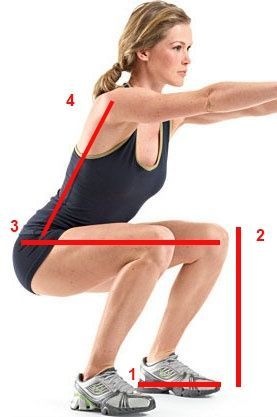The squat is a staple movement in the workout room. It’s a fundamental exercise that works your entire body. There’s a reason the squat has earned the nickname, “the king of all exercise.”
Most people think of the squat primarily as a leg movement. And while your quadriceps, hamstrings, glutes and groin are indeed the prime muscles engaged; your core and lower back muscles work overtime to keep your body upright and stable. Add in weights and even your arm, back and shoulder muscles must come into play.
Whether you’re looking to build power, strength, balance or flexibility, there is a squat variation to help you achieve your training goal. That’s why they should be a regular part of your workout regimen.
However, squats have gotten a negative rap for people with bad knees and lower back issues. While there may be limitations for those who suffer from these injuries; contrary to popular belief, squats are not bad for your knees or back. Squats with bad form are.
A proper squat will strengthen the muscles surrounding your knees and lower back; making these ligaments healthier and stronger. Not injured or weak.
The problem is many gym members haven’t been taught proper form. And unfortunately, you can’t always have a trainer at your side during a workout. Through this following guide, you’ll learn proper form, as well as squat variations to take your workout to the next level.
Squat Form 101
Getting Started
Beginners should focus on perfecting form and technique before adding resistance. Start by performing body weight squats and wall squats.
Squat How To
- Assume athletic stance with feet slightly wider than hip width
- Keeping back straight and knees behind toes, sink hips back and lower into squat until thighs are parallel to ground
- Extend hips and knees to drive up out of squat position
- Repeat for specified reps
Common Squat Mistakes and Solutions
- Knees Collapse Inward: If using a weighted bar, reduce weight for subsequent sets. Also, perform body weight squats with a mini-band wrapped around thighs just above knees to strengthen the muscles that maintain alignment of the knees with the hips and ankles.
- Knees Travel Forward Beyond Toes: Reduce the weight on the bar subsequent sets. Focus on sitting your hips back and keeping your chest up.
- Leaning Forward: Places excessive strain on the lower back. If you find yourself leaning, focus on sitting your hips back and keeping your chest up. In addition, perform body weight squats to improve mobility.
- Rounded Back: Reduce the weight on the bar for subsequent sets. Strengthen the core with exercises like planks before adding additional resistance to your squat.
Advanced Squats
For an additional challenge, increase your squat depth or rise up onto your toes to strengthen your calves. To continue muscle growth, alter the bar and foot positions to challenge your lower-body muscles from different angles. To develop strength equally in both legs and improve, try single-leg exercises.
Squat Exercise Variation
- Front Squat: This variation changes the bar position to the front of the shoulders to eliminate stress on the back.
- Dumbbell Squat: Dumbbells replace the barbell to reduce stress on the upper body, making it ideal for beginning weightlifters.
- Dumbbell Squat and Press: Adds a Shoulder Press to the Squat, which also strengthens the upper body.
- Single-Leg Squat: This bodyweight variation develops single-leg strength and balance for athletes at all levels.
- Dumbbell Split-Squat: This variation, which develops single-leg quad strength, is also good for athletes beginning to lift weight.
- Barbell Split-Squat: An advanced variation of the Split-Squat, this also focuses on single-leg quad strength.
- Dumbbell Rear-Foot-Elevated Split-Squat: With single-leg movement, this variation improves balance while increasing quad and glute strength.
- Rear-Foot-Elevated Split-Squat: An advanced version of the Dumbbell Rear-Foot-Elevated Split-Squat, this exercise increases quad and glute strength and improves balance.


